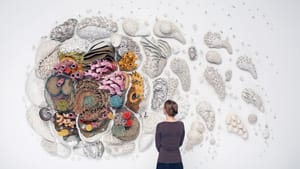Stay in the Loop
BSR publishes on a weekly schedule, with an email newsletter every Wednesday and Thursday morning. There’s no paywall, and subscribing is always free.
The wilds beyond Pyle and the Wyeths
Brandywine River Museum of Art presents Fragile Earth: The Naturalist Impulse in Contemporary Art

Over the past few years, the Brandywine River Museum has been successfully working to broaden its former regional focus on Howard Pyle, the Wyeths, and their circle. Recent memorable forays have included the museum’s 2018 exhibition Natural Wonders: The Sublime in Contemporary Art and their 2021 commission of Ian Stabler’s outdoor installation Queen Anne’s Lace Pod. Now on view, Fragile Earth: The Naturalist Impulse in Contemporary Art, is another elegant, thoughtful step in that laudable aim.
In galleries on two floors, this multimedia exhibition is focused on the human-created vulnerability of our planet. Inspired by 19th-century naturalists’ expertise and world views, four leading contemporary artists, each with a strikingly different artistic practice, are unified here by their compelling case for increased environmental vigilance and action.
The exhibition (curated in 2019 by Jennifer Stettler Parsons) originated at the Florence Griswold Museum in Old Lyme, Connecticut, and the Brandywine is its final venue. Here, curator Amanda Burdan worked with all four artists (over a seven-day installation period) to incorporate recent pieces, and more than 40 percent of the works on view are new.
Cabinets of curiosity
The intimate second-floor Strawbridge Family Gallery houses Jennifer Angus’s immersive, amazingly intricate site-specific installation of preserved insects. Responsibly sourced from insect farms (yes, they exist), the specimens are pinned to the walls in ornamental patterns Angus adapted from a wallpaper design she discovered in the second-floor children’s bedroom of Andrew Wyeth’s studio. She also created “insect wallpaper” by patterning Malaysian periodic cicadas pinned to the wall, and 104 “curiosity boxes” from actual antique cabinet drawers. In addition to low-level museum lighting, the room is illumined by seven custom chandeliers. It’s almost impossible to describe the unexpected impact of this work, like being inside a Victorian parlor’s cabinet of curiosities, an immersion more charming and winning than you might expect.

Conceptual artist, curator, and naturalist Mark Dion has several especially striking works in what becomes the most intellectually focused section of Fragile Earth. Laid out on the floor, Travels of William Bartram Reconsidered (equipment) (2008) displays all the paraphernalia that the artist employed in re-creating that Philadelphia naturalist’s 1770s exploratory horseback journeys (Dion went by car) from the Carolinas to northern Florida.
Referencing the artist’s upbringing in the whaling culture of New Bedford, Massachusetts, New England Cabinet of Marine Debris (2019) features discarded items collected along the shoreline arranged in the fashion of Renaissance cabinets of curiosity. Works new to the exhibition include the sculpture Still Life in Black in White (2022), commenting on the threat oil spills pose to penguins, and a colored pencil study for a proposed Brandywine Conservancy Ranger Station (2021).
Ocean, flora, and fauna
Courtney Mattison is a sculptor, ceramist, marine ecologist, and ocean advocate whose monumental, intricately detailed ceramic wall reliefs reference both the beauty of coral reefs and their immense vulnerability. At Brandywine, Mattison’s works on view include her nine-by-13-foot flagship piece Our Changing Seas III (2014), along with the newer works Surface Tension II (2020) and the beautiful, swirling Gyre I (2022). Though the works seem realistic, the artist never takes coral from the ocean—she works by observation only to create her installations of these lifelike, scientifically inspired ceramics. While cautionary, the entrancing sculptures also focus on the 140 protected marine “Hope Spots” of the organization Mission Blue, evoking the artist’s hope that her work, in the field and the studio, inspires those working for environmental regeneration.
James Prosek has been described as a contemporary John James Audubon and building on the legacy of that artist/naturalist, he considers how we engage with nature both scientifically and artistically. At the entrance to Fragile Earth is a striking Brandywine-commissioned work: a mural (inspired by silhouettes in Roger Tory Peterson’s field guides) painted onsite to highlight Brandywine Valley flora and fauna. Doe Run Red-Breasted Sunfish (2022) is a watercolor of a specimen Prosek caught in the Conservancy’s Laurels Preserve painted on a sheet of Andrew Wyeth’s rare Whatman paper (no longer made) and gifted to the museum. Some of Prosek’s works include taxidermy, and another installation (on the museum’s façade) is a variation on Invisible Boundaries (2021), a work in the gallery incorporating 50 images of state animals and the bald eagle to illuminate how animals inhabit our ecosystems independent of geographic boundaries.
The exhibition is accompanied by a catalogue featuring extensive photography and essays, and upcoming museum events include virtual artist talks on November 16 (Prosek) and December 1 (Mattison). The exhibition website also includes short videos (linked above) on or by each of the artists.
Fragile Earth is a pinpoint balance of artistry and polemics, both a cautionary warning from the front lines of far-seeing artists and, at the same time, a hopeful offering of beauty. And it’s a reminder that, as it often has been, calamity can also produce inspiration.
What, When, Where
Fragile Earth: The Naturalist Impulse in Contemporary Art. Through January 8, 2023, at the Brandywine River Museum of Art, 1 Hoffman’s Mill Road, Chadds Ford. $6-$18 (free for kids under 6). (610) 388-2700 or brandywine.org/museum.
Accessibility
Masks are not required in the museum, but required for touring Wyeth studios; masks are available at the Visitor’s Desk. The entire museum (including café) is wheelchair-accessible, with accessible parking, barrier-free entrance, and available wheelchairs. Service animals welcome.
Sign up for our newsletter
All of the week's new articles, all in one place. Sign up for the free weekly BSR newsletters, and don't miss a conversation.

 Gail Obenreder
Gail Obenreder